
Some teachers devote many weeks of reading and spelling instruction to teaching ‘blends’ but it would be much more time-efficient – and empowering for their students – for them to teach ‘blending’. In this blog, I will explain why, in phonics instruction, thinking of ‘blend’ as a verb rather than a noun will improve your effectiveness as a teacher.
When the word ‘blends’ is used in the context of reading or spelling, it is typically a short-hand for ‘consonant blends’. A consonant blend is a unit comprised of two or three consonants adjacent to each other (not separated by a vowel), with each consonant representing a different speech sound (phoneme) e.g. the consonant blend ‘st’ is /s/ blended with /t/.
 The consonant blend ‘st’.
The consonant blend ‘st’.Blending is the process of ‘pushing’ individual speech sounds together. e.g. /s/ blended with /t/ is ‘st’. Blending can be a simple oral task. In a reading task, it follows the mapping of sounds to letters and allows the learner to decode a written word. In reading words, consonant sounds are blended with vowel sounds and also with other consonant sounds.
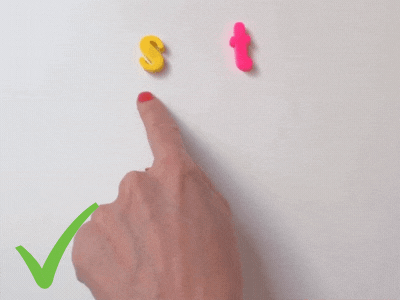 Blending the phonemes /s/ and /t/ together.
Blending the phonemes /s/ and /t/ together.Because the blending of a consonant sound and a vowel sound (e.g. blend together /b/ and /a/, and you get ‘ba’) results in a blend in the same way that the blending of two consonant sounds results in a blend (e.g. ‘st’), the combination of two (or three) adjacent consonants (e.g. ‘str’) in which each consonant represents a different sound would be more accurately explained to learners as a consonant cluster.
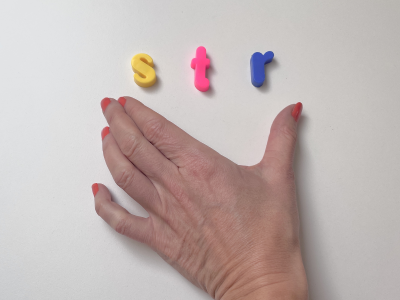 A consonant cluster which includes three sounds.
A consonant cluster which includes three sounds.It must be pointed out that consonant clusters are different to double consonants, like ‘ll’, ‘ss’, ‘ff’, ‘zz’, ‘dd’, ‘gg’, ‘mm’, ‘nn’ and ‘tt’ where two identical consonants together represent only one sound and consonant digraphs, like ‘ch’, ‘sh’, ‘th’ and wh’ where two non-identical consonants together represent only one sound.
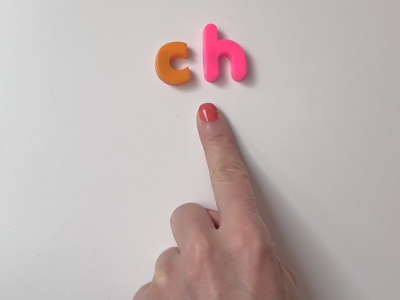 The digraph /ch/ is made of two non-identical consonants which represent one sound.
The digraph /ch/ is made of two non-identical consonants which represent one sound. Double consonants such as ‘mm’ or ‘ss’ represent only one sound.
Double consonants such as ‘mm’ or ‘ss’ represent only one sound.In synthetic phonics instruction, students are taught to pay attention to each letter-sound correspondence from left to right, and all through the word (so the ‘n’ of ‘sun’ is given as much attention as the ‘s’). Consequently, consonant (e.g. d, f, g), double consonant (e.g. ss or ff) and consonant digraph (ch or sh) letter-sound correspondences are explicitly taught. ‘Consonant blends’ (e.g. st or str) are not taught. Blending with, and of, consonant sounds is taught as those sounds are introduced. For example, in Phonics Hero, Level 1 (s, m, c, t, g, p, a, o), some words requiring consonant blending include ‘camp’, ‘stop’, ‘spot’, ‘cost’ and ‘stamp’.
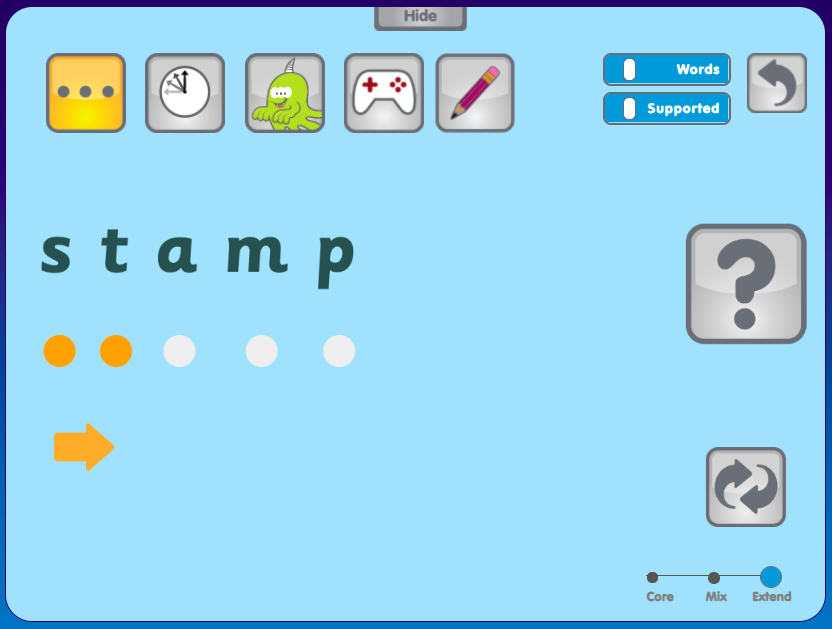 You won’t see any consonant blends in our Phonics Lessons! We use sound buttons to show the individual sounds in more than 3,000 differentiated words.
You won’t see any consonant blends in our Phonics Lessons! We use sound buttons to show the individual sounds in more than 3,000 differentiated words.It is generally agreed that there are 27 or 28 consonant clusters that come at the beginning of syllables (e.g. bl, str) and 48 or 49 consonant clusters that come at the end (e.g. nd, mpt). Three can be found in either position: sk, st and sp. Because every word must have a vowel sound ALL consonant clusters must be blended with a vowel sound.
So why are consonant sounds blended with other consonant sounds given so much special attention in some phonics programs? Here are my hypotheses:
There are approximately 176 spellings for the 44 sounds of English for learners to remember.
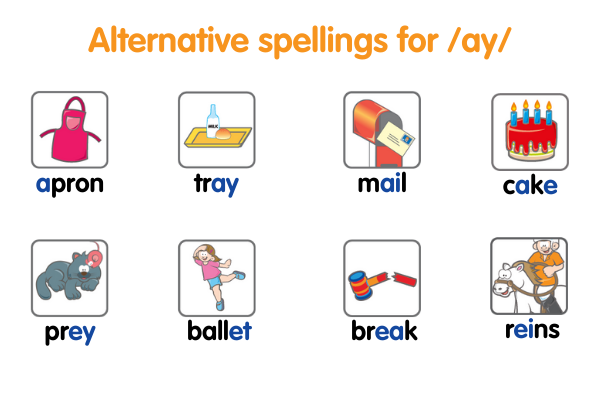
When children are taught blends as units, they are being asked to learn and remember separate pieces of code knowledge in addition to the spellings of individual sounds. This increases the amount of information students must commit to memory and the likelihood of cognitive overload.
If you are not sure about how to teach blending, you can read some clever ideas in the Phonics Hero blog post Helping the Blending Penny Drop. The basic principles are:
ALWAYS follow teaching of letter-sound correspondences with blending activities. The second step in the Phonics Hero games is Reading, in which learners play games which practise blending the taught letter-sound correspondences to read words.
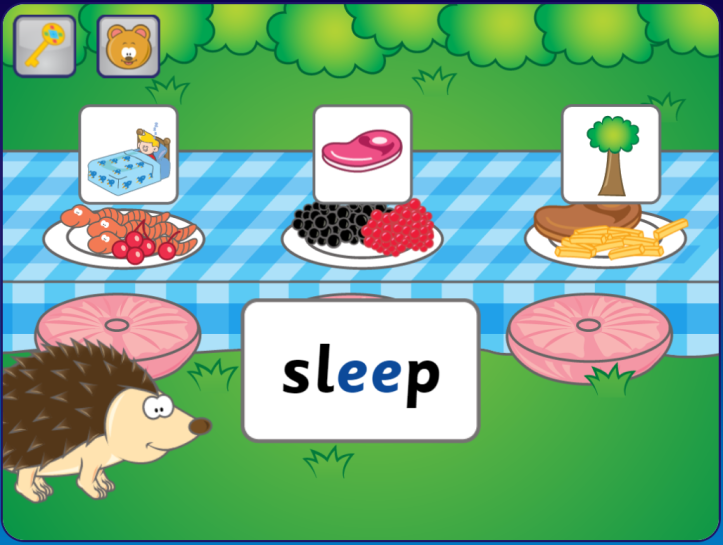 One of over 150 single-word blending games from the Child Accounts.
One of over 150 single-word blending games from the Child Accounts. 
Follow these tips to save yourself and your students the time you would have spent unnecessarily teaching ‘blends’. Reap the benefits of the time you can now spend on blending activities.
Good morning,
can you please help I am TA4 and been asked to work with a low ability group using phonics to improve their reading skills. Have you any advise please.
Thank you
Trish
Dear Trish,
Thank you for your question. My blog post Catching Up on Phonics After Lockdown (https://phonicshero.com/phonics-catch-up/) is a good place to start as it’s written for teachers working with students who’ve ended up behind as result of the pandemic. Assessment is absolutely key and will help you prioritise and structure your lessons according to the needs of the group.
If you don’t have a Phonics Hero Teacher Account already, I recommend creating one and signing up for a free 30-day trial of Phonics Lessons. Phonics Lessons help structure your lesson for you, enabling you to explicitly and systematically teach the sounds, blending, reading, and segmenting. The lessons include 3,500 decodable words, 1,000 nonsense words and 2,000 decodable sentences and support features to adjust the difficulty of the lesson. You can learn more about the Phonics Lessons here: https://phonicshero.com/for-teachers/phonics-lessons-tour/.
You will also need decodable readers. I recommend PhonicBooks UK (https://www.phonicbooks.co.uk/) and Little Learners Love Literacy (https://www.littlelearnersloveliteracy).
I hope this is helpful to you.
Shirley